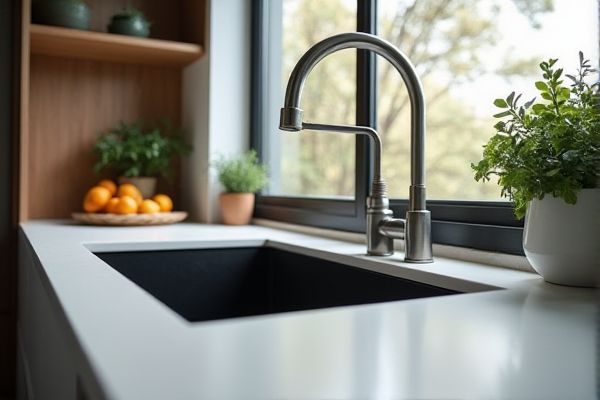
A deep sink offers ample capacity for washing larger pots and pans, while a low divide sink provides a wider, shallower space that allows easier access and multitasking between compartments. Discover which sink style suits Your kitchen needs best by exploring the full comparison in the article ahead.
Table of Comparison
| Feature | Deep Sink | Low Divide Sink |
|---|---|---|
| Depth | High - longer basin for large items | Shallow - shorter basin depth |
| Use Case | Ideal for washing large pots, pans, and bulk dishes | Best for quick rinsing and limited counter space |
| Installation | Requires more cabinet space underneath | Fits smaller kitchen layouts comfortably |
| Cleaning Efficiency | Superior for soaking and deep cleaning | Efficient for everyday light washing tasks |
| Water Usage | Tends to use more water due to size | Conserves water with smaller basin volume |
| Cost | Generally higher price range | More affordable, budget-friendly option |
Introduction to Deep Sinks and Low Divide Sinks
Deep sinks are plumbing fixtures characterized by their increased depth, allowing for greater water capacity and accommodating larger pots and dishes, making them ideal for heavy kitchen tasks. Low divide sinks feature a shorter partition between two basins, enhancing flexibility by enabling easier washing and rinsing of larger items across both compartments. These sink types optimize kitchen efficiency by balancing space utilization and functional accessibility.
Key Differences Between Deep and Low Divide Sinks
Deep sinks offer a significant basin capacity, ideal for washing large pots and pans, while low divide sinks feature a shorter partition, providing easier access and more workspace in the larger compartment. The high wall of a deep sink prevents splashing and contains water more effectively, whereas low divide sinks enhance usability with their ergonomic design, allowing seamless transitions between sink sections. Choosing between these depends on your kitchen needs, prioritizing either volume and splash control or accessibility and multitasking efficiency.
Pros and Cons of Deep Sinks
Deep sinks provide ample space for washing large pots and pans, reducing splashes and improving cleaning efficiency. However, they can be more difficult to reach into, requiring greater effort and potentially causing strain for users. Lower divide sinks offer easier access but may lack the capacity needed for bulky kitchen tasks, making deep sinks preferable for heavy-duty use despite their ergonomic drawbacks.
Pros and Cons of Low Divide Sinks
Low divide sinks offer the advantage of maintaining water temperature by reducing air exposure between basins, which improves energy efficiency during dishwashing and rinsing tasks. They typically require less countertop space and provide a seamless surface for cleaning, but their narrower divider can limit the ability to soak or wash large pots simultaneously. However, the reduced depth or divider height may cause more splashing, making them less ideal for heavy-duty kitchen use compared to deep sinks.
Space and Installation Considerations
Deep sinks offer increased basin capacity, making them ideal for handling large pots and pans, but they require more under-counter clearance and robust support during installation. Low divide sinks, featuring a lower partition between basins, maximize usable workspace and facilitate multitasking, yet they demand precise alignment and custom fitting to ensure proper drainage and stability. Both sink types necessitate careful measurement of cabinet dimensions and countertop thickness to optimize space utilization and installation efficiency.
Cleaning and Maintenance Comparison
Deep sinks offer superior capacity for washing large pots and pans, minimizing splash and making cleaning more efficient, while low divide sinks separate compartments for multitasking but may limit space for bulky items. Deep sinks typically require less frequent splashing and provide easier rinsing due to their depth, reducing the frequency of scrubbing around edges compared to low divide sinks. Low divide sinks, with their smaller, divided basins, often demand more careful maintenance to prevent food debris buildup in corners and seams, potentially increasing cleaning time.
Functionality for Different Kitchen Tasks
Deep sinks provide ample space and depth for washing large pots, pans, and bulky kitchenware, enhancing their functionality for heavy-duty cleaning tasks. Low divide sinks, with their shallow basins and partitioned sections, facilitate multitasking by allowing simultaneous rinsing and washing of smaller items with ease. Choosing the right sink improves your kitchen efficiency by matching functionality to the specific tasks you perform most often.
Style and Design Options
Deep sinks offer a bold, functional design ideal for accommodating large pots and pans, often crafted from materials like stainless steel or fireclay, complementing modern or industrial kitchen styles. Low divide sinks feature a distinct style with a lowered divider that provides versatile usage in smaller spaces, available in various materials including composite granite and enameled cast iron, matching traditional or farmhouse aesthetics. Both sink types present diverse size and finish options, allowing customization to enhance kitchen workflows and design coherence.
Cost and Budget Factors
Deep sinks generally require higher initial costs due to increased material use and more complex installation processes, impacting overall kitchen renovation budgets. Low divide sinks tend to be more budget-friendly as their shallower design uses less material and simplifies plumbing requirements. Choosing between the two depends on balancing aesthetic preferences with long-term cost considerations, including potential maintenance and durability expenses.
Choosing the Right Sink for Your Kitchen Needs
Deep sinks offer ample capacity for washing large pots and pans, making them ideal for busy kitchens with heavy cookware. Low divide sinks provide a practical solution for multitasking, allowing for simultaneous washing and rinsing while maintaining counter space efficiency. Selecting the right sink depends on your kitchen workflow, space availability, and specific usage requirements to enhance functionality and convenience.
 homyna.com
homyna.com